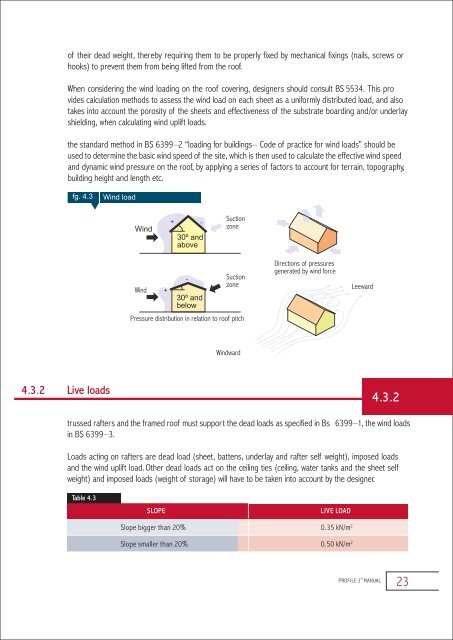PROFILE 3 (SLW & ULTIMATE).pdf - Emenite Limited
PROFILE 3 (SLW & ULTIMATE).pdf - Emenite Limited
PROFILE 3 (SLW & ULTIMATE).pdf - Emenite Limited
Create successful ePaper yourself
Turn your PDF publications into a flip-book with our unique Google optimized e-Paper software.
of their dead weight, thereby requiring them to be properly fixed by mechanical fixings (nails, screws orhooks) to prevent them from being lifted from the roof.-When considering the wind loading on the roof covering, designers should consult BS 5534. This provides calculation methods to assess the wind load on each sheet as a uniformly distributed load, and alsotakes into account the porosity of the sheets and effectiveness of the substrate boarding and/or underlayshielding, when calculating wind uplift loads.the standard method in BS 6399–2 “loading for buildings– Code of practice for wind loads” should beused to determine the basic wind speed of the site, which is then used to calculate the effective wind speedand dynamic wind pressure on the roof, by applying a series of factors to account for terrain, topography,building height and length etc.fg. 4.3Wind loadWind+-30º andaboveSuctionzoneWind+-30º andbelowSuctionzonePressure distribution in relation to roof pitchDirections of pressuresgenerated by wind forceLeewardWindward4.3.2 Live loadstrussed rafters and the framed roof must support the dead loads as specified in Bs 6399–1, the wind loadsin BS 6399–3.Loads acting on rafters are dead load (sheet, battens, underlay and rafter self weight), imposed loadsand the wind uplift load. Other dead loads act on the ceiling ties (ceiling, water tanks and the sheet selfweight) and imposed loads (weight of storage) will have to be taken into account by the designer.Table 4.34.3.2SLOPELIVE LOADSlope bigger than 20% 0.35 kN/m 2®<strong>PROFILE</strong> 3 MANUAL23


